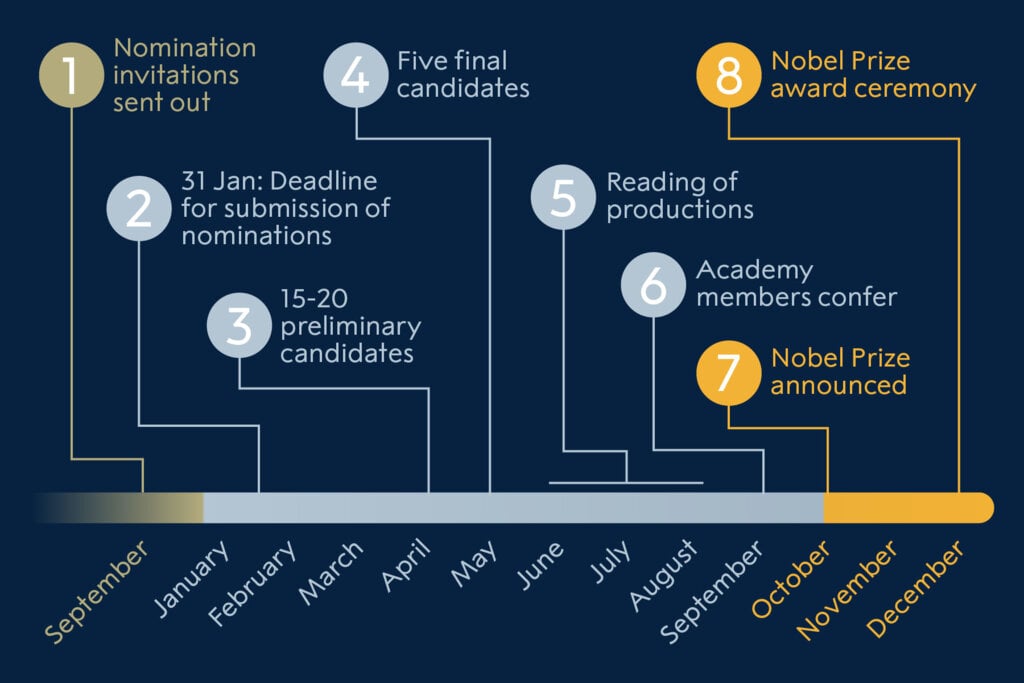Nominations to the Nobel Prize in Literature can be made by qualified persons only. The names of the nominees and other information about the nominations cannot be revealed until 50 years later.
Process of nomination and selection
The Nobel Committee for Literature sends invitation letters to persons who are qualified to nominate for the Nobel Prize in Literature.
Qualified nominators
The right to submit proposals for the award of a Nobel Prize in Literature shall, by statute, be enjoyed by:
- Members of the Swedish Academy and of other academies, institutions and societies which are similar to it in construction and purpose;
- Professors of literature and of linguistics at universities and university colleges;
- Previous Nobel Prize laureates in literature;
- Presidents of those societies of authors that are representative of the literary production in their respective countries.
Selection of Nobel Prize laureates
The Swedish Academy is responsible for the selection of the Nobel Prize laureates in literature, and has 18 members. The Nobel Committee for Literature is the working body that evaluates the nominations and presents its recommendations to the Swedish Academy, and comprises four to five members.
Who is eligible for the Nobel Prize in Literature?
The candidates eligible for the literature prize are those nominated by qualified persons (see below) who have received an invitation from the Nobel Committee to submit names for consideration. Other persons who are qualified to nominate but have not received invitations may also submit nominations. No one can nominate himself or herself.
How are the literature laureates selected?

Below is a brief description of the process involved in choosing the Nobel Prize laureates in literature.
September – Invitation letters are sent out. The Nobel Committee sends out nomination forms to hundreds of individuals and organizations qualified to nominate for the Nobel Prize in Literature.
February – Deadline for submission. The completed forms must reach the Nobel Committee not later than 31 January of the following year. The Committee then screens the nominations and submits a list for approval by the Academy.
April – Preliminary candidates. After further studies, the Committee selects 15–20 names for consideration as preliminary candidates by the Academy.
May – Final candidates. The Committee whittles down the list to five priority candidates to be considered by the Academy.
June-August – Reading of productions. The members of the Academy read and assess the work of the final candidates during the summer. The Nobel Committee also prepares individual reports.
September – Academy members confer. Having read the work of the final candidates, members of the Academy discuss the merits of the different candidates’ contribution.
October – Nobel Prize laureates are chosen. In early October, the Academy chooses the Nobel Prize laureate in literature. A candidate must receive more than half of the votes cast. The Nobel Prize laureates names are then announced.
December – Nobel Prize laureates receive their prize. The Nobel Prize award ceremony takes place on 10 December in Stockholm, where the Nobel Prize laureates receive their Nobel Prize, which consists of a Nobel Prize medal and diploma, and a document confirming the prize amount.
Are the nominations made public?
The statutes of the Nobel Foundation restrict disclosure of information about the nominations, whether publicly or privately, for 50 years. The restriction concerns the nominees and nominators, as well as investigations and opinions related to the award of a prize.
More information at the website of the Swedish Academy
Search the nomination database
Read more about how the Nobel Prize laureates are nominated:
Nomination of the physics laureates
Nomination of the chemistry laureates
Nomination of the medicine laureates
Nomination of the literature laureates
Nomination of the peace laureates
Nomination of the economic sciences laureates